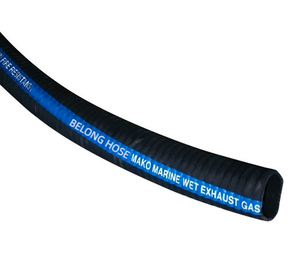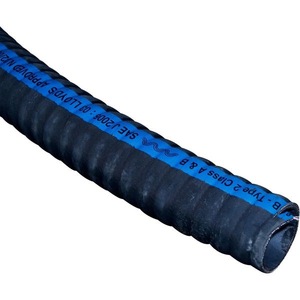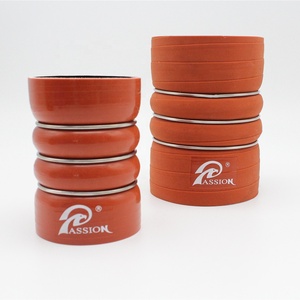(212 products available)






























































































































































































A wet exhaust pipe is designed to carry exhaust fumes and cooling water from engines. It is commonly used in marine vessels and vehicles. There are two main types of wet exhaust hoses:
Wire Reinforced Hose
The wire-reinforced wet exhaust hose has internal and external wire coils. The wire coils on the outside of the hose help to protect it from damage. They also add to the strength of the hose. The wire coils on the inside of the hose prevent it from collapsing when it is being used. This type of hose is available in different sizes to meet the needs of various applications. It also comes in different lengths and can be cut to the desired size. The wire reinforced hose has a high burst pressure and high tensile strength. It is also resistant to abrasion.
Silicone Hose
The silicone wet exhaust hose is designed to carry exhaust fumes and water from cooling. It is made from high-quality silicone material. The silicone hose can handle high pressure and temperature. It is also durable and corrosion resistant. Silicone has superior material properties, which makes it a popular choice for applications that require high-performance hoses. The silicone wet exhaust hose is used in various applications, such as automotive, marine, and industrial. It is preferred for applications that require a reliable and high-performance hose.
The following are specifications that buyers should pay attention to when buying a wet exhaust hose.
Construction Material
Wet exhaust hoses are constructed from various materials. One of the most common materials is reinforced rubber. It is used because of its strength, flexibility, and durability. Additionally, it can withstand high-pressure conditions. Some hoses are made from silicone. Silicone is a heat-resistant material that is also very flexible. Another material that may be used is PVC. PVC is a cheaper material, but it cannot withstand high temperatures and pressures like silicone and rubber. Hoses made from PVC should be used in applications where the pressure and water temperatures are low.
Size
The size of the wet exhaust hoses differs depending on the application and the specific needs of the user. The lengths range from a few meters to over ten meters. When choosing the length, ensure that it is long enough to connect all the necessary parts without straining. The internal diameter of the hose also varies. It ranges from 25mm to 150mm. A larger diameter means a larger flow of exhaust. The diameter should be chosen depending on the system's design.
Temperature Resistance
The hoses are designed to withstand high temperatures. Some can handle temperatures of up to 200 degrees Celsius. When selecting a hose, consider the temperatures the exhaust emits. The hose has to be able to withstand the temperature to avoid damage.
Pressure Rating
Wet exhaust hoses have different pressure ratings. The maximum pressure for some hoses is 5 bars, while others can handle pressures of up to 10 bars. The chosen hose should have a pressure rating that is higher than the pressure emitted by the exhaust.
Hose Construction
Wet exhaust hoses are constructed in various ways. For example, some are multi-layered. They have more than one layer, which helps to improve their strength and durability. Other construction methods include the use of braided reinforcement.
Compliance with Standards
Wet exhaust hoses are manufactured according to various industry standards. These standards make sure that the hoses are safe and reliable.
Wet exhaust hose maintenance is very important. It improves the longevity of the hose and prevents costly repairs. Users should do the following.
Choosing the right wet exhaust hose for a specific application is crucial for ensuring optimal performance and longevity. Here are some important factors to consider when choosing a wet exhaust hose:
1. Size and Diameter
When choosing a wet exhaust hose, it is important to consider the size and diameter. It is advisable to choose a hose that fits the exhaust outlet and matches the engine's specifications. A properly fitted hose ensures optimal exhaust flow and prevents leaks or back pressure. The hose diameter also affects the noise level, with larger diameters offering a quieter operation.
2. Construction Material
Construction material is another important factor to consider when choosing a wet exhaust hose. This is because the material affects the hose's durability, flexibility, and resistance to heat and chemicals. Common materials used in wet exhaust hoses include silicone, reinforced rubber, and PVC. Silicone hoses offer superior heat resistance and durability, making them ideal for high-performance applications. PVC hoses are more affordable but may not withstand extreme temperatures and pressures.
3. Temperature and Pressure Ratings
Wet exhaust systems contain high-temperature exhaust gases. Therefore, it is advisable to choose hoses with high-temperature and high-pressure ratings to handle the conditions without degrading or failing. The chosen hose should have a temperature range that exceeds the maximum temperature of the exhaust gases. Additionally, considering the pressure ratings is important to ensure that the hose can withstand the pressure generated by the engine without bursting or leaking.
4. Length and Bend Radius
When choosing a wet exhaust hose, the length and bend radius should also be considered. This is important because the hose length affects the exhaust flow and potentially the noise level. A longer hose may result in a reduction in exhaust flow and an increase in noise. Additionally, the bend radius should be considered to avoid sharp bends that may restrict the exhaust flow and damage the hose.
5. Compatibility and Standards
Before choosing a wet exhaust hose, it is important to ensure compatibility with the exhaust system components. This is crucial in ensuring a proper fit and preventing leaks or failures. Additionally, the chosen hose should meet relevant industry standards and regulations, such as emissions requirements and safety standards.
6. Flexibility and Ease of Installation
Consider the flexibility and ease of installation of the wet exhaust hose. A flexible hose can accommodate bends and twists in the exhaust system, making installation easier and reducing the risk of hose failure due to stress or strain. Additionally, choosing a hose with smooth inner linings is important for easy installation and optimal exhaust flow.
7. Durability and Longevity
Wet exhaust hoses are subjected to harsh conditions, including exposure to high temperatures, chemicals, and abrasive particles. Therefore, it is important to choose a hose constructed with durable and long-lasting materials to withstand these conditions and provide reliable performance over time. Consider factors such as abrasion resistance, chemical compatibility, and resistance to UV degradation when selecting a hose.
8. Noise Reduction
In some applications, noise reduction is a crucial factor when choosing a wet exhaust hose. If noise is a concern, consider hoses designed with noise-dampening features or opt for larger-diameter hoses, which may result in a quieter operation.
9. Budget and Cost-effectiveness
Finally, consider the budget and the cost-effectiveness of the chosen wet exhaust hose. While high-quality hoses may have a higher initial cost, they can save money in the long run by providing durability, reliability, and optimal performance, reducing maintenance and replacement needs.
Before replacing a wet exhaust pipe, it's important to note that not all hoses are the same. They come in different sizes and shapes depending on the engine's make and model. Additionally, the type of material may vary. However, the process is pretty straightforward. Here are some general steps to take when replacing a wet exhaust hose:
Q1: What is a wet exhaust hose?
A1: A wet exhaust hose is a type of hose used in marine and industrial applications to carry exhaust gases from engines. It is designed to handle the presence of water in the exhaust, such as seawater or cooling water, mixed with the exhaust gases.
Q2: Where is a wet exhaust hose used?
A2: Wet exhaust hoses are commonly used in boating and marine environments, where engines exhaust cooling water. They are also used in industrial engines and equipment where exhaust cooling water is present.
Q3: What is the difference between a wet and dry exhaust?
A3: A wet exhaust refers to an exhaust system where cooling water is mixed with the exhaust gases, typically seen in marine applications. A dry exhaust, on the other hand, does not mix cooling water with the exhaust gases, keeping the exhaust system internal and high-temperature in terrestrial applications.
Q4: What is a marine exhaust hose?
A4: A marine exhaust hose is specifically designed for use in marine applications, such as boat and yacht exhaust systems. It is built to withstand harsh environmental conditions, including UV exposure, saltwater, and high temperatures, ensuring durability and reliability in marine settings.